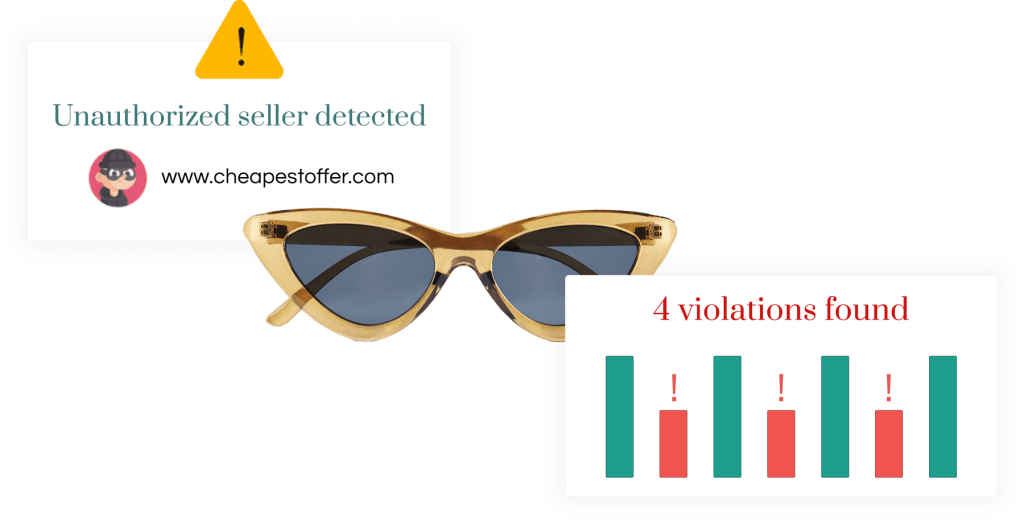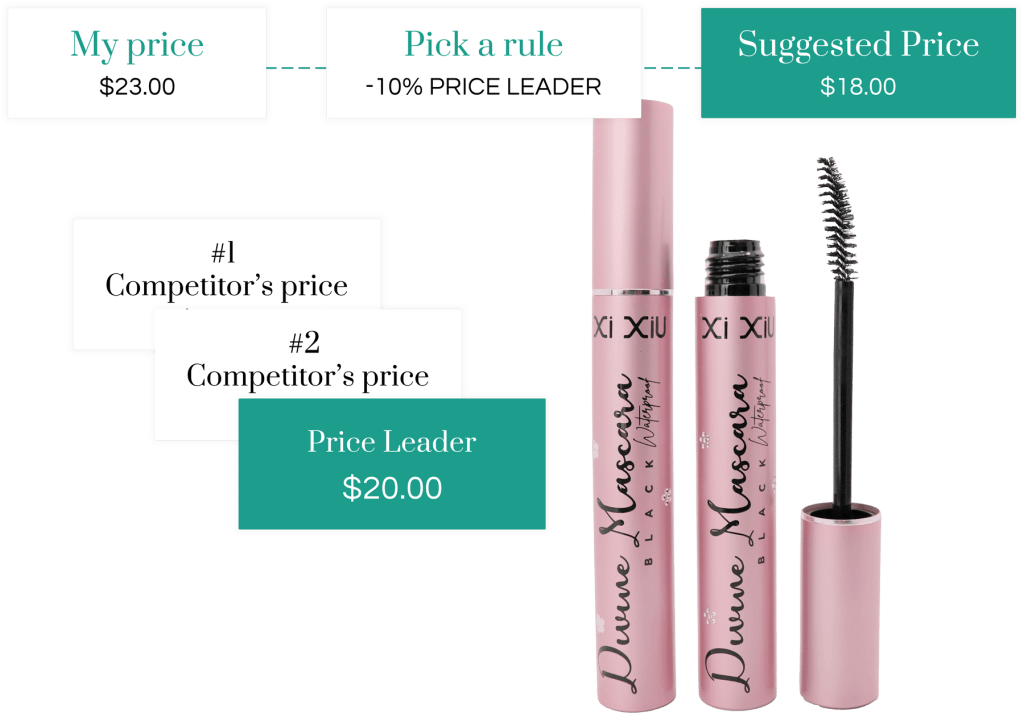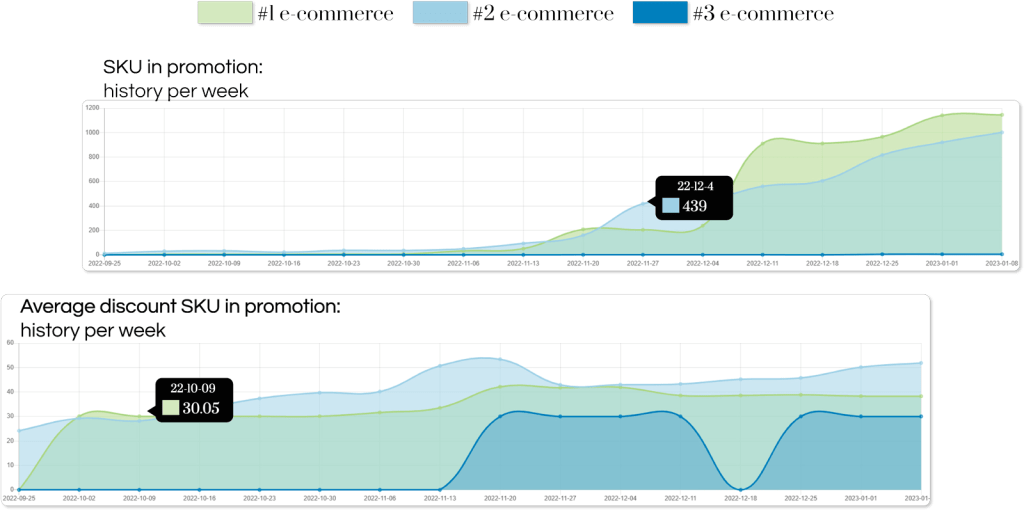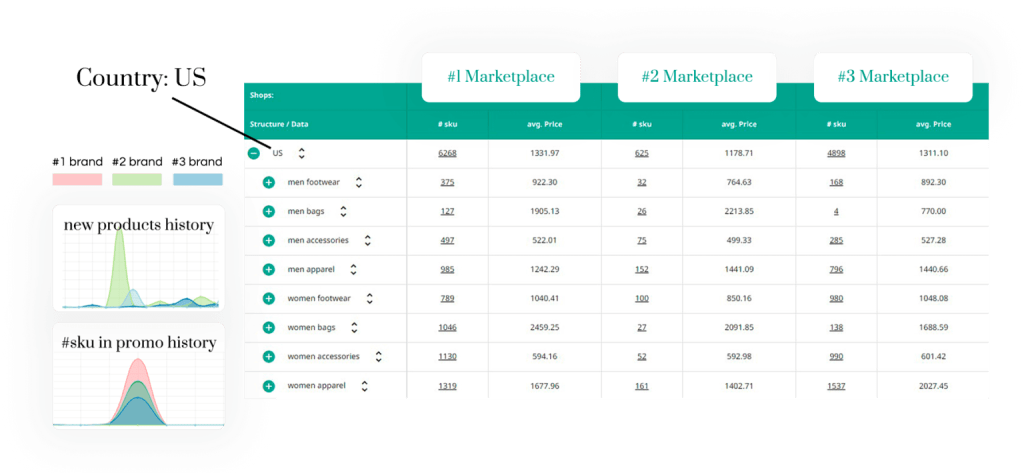As the holiday season approaches, there is undoubtedly a lot of excitement and nervousness. The excitement of increased sales potential during peak shopping seasons like Black Friday and Cyber Monday also requires business owners to brace for the impact of fierce competition.
As a business owner, you might be wondering if there is a way to get the best of this time. How do you make your brand stand out, keep your prices competitive, and still maintain healthy profit margins? But don’t worry, you’re not alone in this.
The good news is that there’s a solution to help you cruise these choppy waters: competitor price tracking. By keeping an eye on what your competitors are doing and the general weather of the market, you can make informed decisions that not just increase your sales but also build trust with your customers and strengthen your relationships with retailers.
Today, let’s see some ways in which you can thrive during peak shopping seasons with a benchmarking tool. From managing major sales events to preventing price wars and ensuring consistent promotions, we’ll cover everything you need to know to make this holiday season a success. So, let’s get started!
7 Ways To Thrive During Peak Shopping Seasons With Competitor Price Tracking
Understanding competitor pricing can feel like an overwhelming task, especially during these busy times. However, with the right approach and tools, you can turn this challenge into an opportunity to thrive.
Combat Holiday Price Wars
Holiday and peak seasons are common times for brands to engage in price wars, a practice of cutting down prices of products significantly to entice more customers. As these periods see an influx of consumers looking for the best deals, often the cheapest ones, retailers go all out to get revenue, at times even at the expense of profit margins. In such a situation, even a slight price difference can sway their purchasing decision.
Engaging in price wars without a strategic approach can erode profit margins and damage brand value. Failing to stay competitive can result in lost sales and reduced market share. Therefore, it is crucial to have a well-planned strategy to navigate these price wars effectively.

Tips To Implement
A competitor benchmarking tool provides real-time insights into competitors’ pricing strategies.
- Real-Time Dynamic Price Tracking: Stay updated on competitors’ price changes instantly, allowing you to adjust your prices dynamically.
- Historical Price Analysis enables you to understand past pricing trends to predict future price movements and plan your pricing strategy accordingly.
- Alert Systems: Get instant alerts when a competitor changes their price, and use this information to respond promptly.
- Market Dynamics Insights: Gain a comprehensive understanding of market trends and competitor strategies, helping you make informed pricing decisions.
Best Practices
- Monitor Competitors Regularly: Use a competitor benchmarking tool to keep a constant watch on the market, but make strategic decisions based on comprehensive data analysis rather than knee-jerk reactions.
- Set Minimum Price Thresholds: Establish minimum price limits to ensure that you do not sell below cost or MAP(minimum advertised price). Regularly review and enforce MAP policies to maintain brand integrity, avoid penalties, and prevent unauthorized price drops that can devalue a brand.
- Consider Extra Treats: Instead of just lowering prices, consider adding value through bundled offers, loyalty programs, membership passes, or enhanced customer service.
What to Avoid
- Overreacting to Competitor Prices: Constantly changing prices in reaction to competitors can confuse customers and damage your brand’s perceived value. Set a pricing strategy beforehand and use this to guide any changes.
- Ignoring Profit Margins: In the heat of a price war, it’s easy to forget about maintaining healthy profit margins. Ensure that your pricing strategy balances competitiveness with profitability.
- Lack of Differentiation: Competing solely on price can lead to a race to the bottom. Ensure that your value proposition includes much more than an attractive price- like quality, service, and brand reputation.
Manage Black Friday, Cyber Monday, & Holiday Sales
Black Friday and Cyber Monday are two of the most significant shopping events of the year, driving massive consumer spending. The importance of the holiday season goes without saying. Retailers often see a substantial portion of their annual sales these days, and this is a chance one cannot miss out on.
However, the intense competition and high consumer expectations can make it challenging to stand out. Effective management of these sales events is crucial to maximize revenue, enhance customer happiness, and maintain long-term loyalty.

Tips To Implement
- Real-Time Price Monitoring: Track competitors’ prices in real-time to ensure your offers are competitive without sacrificing margins. Keep a close eye on the general prices to get the best out of this season.
- Historical Data Analysis: Study past sales data to identify trends and predict consumer behavior, helping you plan your pricing and inventory strategies.
- Promotional Insights: Gain insights into competitors’ promotional strategies, allowing you to craft compelling offers that attract more customers.
- Dynamic Pricing: Implement dynamic pricing strategies based on real-time market data to optimize sales and profitability.
- Geo-pricing: Ensure your offers during the peak seasons are not one-size-fits-all. Each region is different and the spending capacity varies as you cross borders. To get multi-national success, utilize the insights a benchmarking tool provides to understand your audience better.
Best Practices
- Plan Early: Start planning your Black Friday, Cyber Monday, and Holiday season strategies well in advance to ensure you have enough time to analyze data and prepare.
- Leverage Data: Use data from your competitor benchmarking tool to make informed decisions about pricing, promotions, and inventory.
- Enhance Customer Experience: Ensure your website can handle increased traffic and provide excellent customer service to build long-term loyalty.
- Monitor Competitors: Keep a close watch on competitors’ strategies and be prepared to adjust your approach as needed to stay competitive.
What to Avoid
- Overstocking or Understocking: Misjudging inventory levels can lead to stockouts or excess inventory, both of which can hurt your bottom line. Integrate your competitor price tracking tool with inventory software to get accurate information about each product.
- Ignoring Customer Experience: Focusing solely on price can lead to neglecting other critical aspects of the customer experience, such as website performance and customer service.
Ensure Consistent Promotions
If you are employing multiple channels to reach out to your customers, it is necessary to ensure the same promotional offers across- to speak the same language consistently for maintaining customer interest and driving sales throughout the year. Inconsistent promotions can confuse customers and lead to missed sales opportunities. A competitor benchmarking tool ensures that promotions are competitive yet consistent with market standards. It provides insights into competitors’ promotional strategies and helps retailers align their offers, avoiding drastic price changes that can alienate customers.

Tips To Implement
- Promotion Tracking: Monitor competitors’ promotional activities to identify trends and gaps in the market.
- Performance Analysis: Analyze the effectiveness of past promotions to understand what works and what doesn’t and to modify strategies accordingly. For instance, an active offer on your website may not be getting the required traction and instead get a lot of attention from social media and other e-commerce marketplaces.
- Competitive Positioning: Ensure your promotions are competitive by comparing them with those of your competitors.
- Market Trends: Stay on top of market trends to create timely and relevant promotions.
Best Practices
- Plan a Promotion Calendar: Create a promotion calendar to ensure a steady stream of promotions throughout the year. Leverage data from your competitor benchmarking tool to plan and execute effective promotions.
- Test and Optimize: Continuously test different promotional strategies and optimize based on performance data.
- Align with Marketing Campaigns: Ensure that your promotions are aligned with your overall marketing campaigns for maximum impact.
What to Avoid
- Over-Promotion: Too many promotions can devalue your brand and lead to customers waiting for discounts instead of buying at regular prices. It encourages a customer to procrastinate a purchase, thinking, ‘There will always be a better offer tomorrow.’
- Inconsistent Messaging: Ensure that your promotional messaging is consistent across all channels to avoid confusing customers.
- Ignoring Data: Failing to analyze the performance of past promotions can result in repeating mistakes and missing opportunities for improvement.
Want to maximize profits this shopping season?
Nurture Customer Trust
Customer trust is the not-so-secret ingredient of a successful business. Trust leads to customer loyalty, repeat purchases, and positive word-of-mouth. Nurturing customer trust can be a challenge yet a significant differentiator that sets your brand apart in a competitive market. By monitoring competitors’ prices and ensuring fair pricing, businesses can avoid practices that might be perceived as deceptive or unfair by customers and ensure brand value protection.
Tips To Implement
- Price Transparency: Ensure your prices are competitive and fair by monitoring competitors’ pricing strategies.
- Consistent Value: Provide consistent value to customers by offering competitive prices and high-quality products.
- Market Positioning: Understand your market position relative to competitors and convey your USP or unique value proposition better.
- Customer Feedback: Monitor customer feedback on competitors to identify how you can improve and build trust.
Best Practices
- Transparent Pricing: Be clear and accurate about your pricing and any changes to build trust with customers.
- Engage with Customers: Actively and regularly interact with customers and address their concerns promptly.
- Leverage Data: Use data from your competitor benchmarking tool to understand customer expectations and meet them consistently.
What to Avoid
- Deceptive Pricing: Misleading discounts or hidden costs can erode customer trust.
- Price Gouging: Avoid sudden and unjustified price increases, as they can erode customer trust.
- Inconsistent Promotions: Frequent changes in promotional strategies can confuse and frustrate customers.
- Inadequate Support: Not addressing customer concerns about pricing can damage the brand’s reputation. Ensure to be there for your customers if you want them to return.
Invest in Retailer, Supplier Relationships
Strong relationships with retailers and suppliers ensure product availability, optimize distribution, and drive sales. These relationships can throw light on valuable insights into market trends and customer preferences and get you better deals for wider profit margins. Strong relationships with retailers and suppliers are vital for ensuring product availability, compliance with pricing policies, and gaining favorable shelf space.

Tips To Implement
- Performance Metrics: Share performance metrics with retailers to demonstrate your products’ value and identify improvement areas.
- Collaborative Planning: Use data to collaborate with retailers on promotions, pricing strategies, and inventory management. Listen to retailers’ and suppliers’ concerns and adjust strategies accordingly to maintain strong relationships.
- Supplier Negotiations: Utilize competitor pricing data to strike better deals with suppliers and boost profits. During peak seasons with high order volume, this can be beneficial.
- MAP Enforcement: Use benchmarking tools to ensure adherence to MAP policies and prevent deviations.
Best Practices
- Regular Communication: Maintain regular communication with retailers and suppliers to keep them informed and engaged.
- Collaborative Approach: Work collaboratively with retailers and suppliers to develop strategies that benefit both parties.
- Data-Driven Decisions: Use data from your competitor benchmarking tool to make informed decisions and support retailers’ and suppliers’ efforts.
- Address Feedback: Actively address retailer feedback to build trust and strengthen relationships.
What to Avoid
- Inflexibility: Being inflexible in your approach can strain relationships with retailers and suppliers and limit collaboration.
- Violating MAP Policies: Non-compliance can strain relationships with retailers and suppliers and lead to penalties.
- Uncompetitive Pricing: Ignoring market trends can make products less attractive to retailers and suppliers.
Boost Marketing Efforts
To get the best out of peak sale periods, it is important to mesh effective marketing strategies along with your sales efforts. A good competitor benchmarking tool provides insights into competitors’ marketing and promotional tactics. This enables businesses to refine their own marketing efforts, ensuring they strike the right chord with consumers from the get go.
Tips To Implement
- Performance Metrics: Track the performance of your marketing campaigns and make data-driven adjustments to optimize results.
- Customer Insights: Tailor your marketing messages and offers using insights into customer behavior and preferences.
- Customer-Centric Approach: Focus on understanding and meeting customer needs and preferences in your marketing efforts.
Best Practices
- Integrated Marketing Strategy: Devise a comprehensive marketing strategy that complements your business goals and leverages multiple channels.
- Data-Driven Campaigns: Use data from your competitor benchmarking tool to create data-driven marketing campaigns that resonate with your target audience.
- Continuous Optimization: Monitor and optimize your marketing campaigns regularly based on performance data.
What to Avoid
- Copying Competitors: Blindly copying competitors’ marketing strategies can dilute brand identity. The repetition of messaging will not excite customers and the probability of your brand standing out diminishes.
- Neglecting Unique Value: Focusing solely on price competition can overshadow the unique value propositions of your products. Devise clear and concise messaging on what makes you unique from others.
- Inconsistent Messaging: Disjointed marketing messages can confuse customers and weaken the brand. Be consistent throughout.
Optimize Inventory & Stocks
Effective inventory management helps you to easily meet customer demand, minimizing stockouts, and reducing excess inventory. Optimizing inventory and stocks can improve cash flow, enhance customer satisfaction, and drive business success. It is necessary to build a resilient supply chain that can withstand any disruptions, especially during peak times.

Tips To Implement
- Demand Forecasting: Predict future demands for products using historical data and market trends. Plan your inventory levels accordingly.
- Inventory Turnover: Track inventory turnover rates to ensure efficient stock management and minimize excess inventory. If you notice a competitor product selling out quickly, you can switch your focus to similar products and keep inventory ready to welcome this.
- Supply Chain Insights: Gain insights into supply chain dynamics to optimize order fulfillment and reduce lead times.
Best Practices
- Negotiate better, mutually beneficial deals with suppliers and enhance your profit margins. Work collaboratively with suppliers and partners to optimize the supply chain and reduce lead times.
- Leverage Technology: Use advanced inventory management tools and technologies to gain real-time insights and improve stock management.
- Regular Inventory Audits: Conduct audits regularly and bookkeep stock levels to ensure your inventory is optimal. Adjust inventory levels dynamically based on real-time market data and competitor insights.
What to Avoid
- Overstocking or Understocking: Misjudging inventory levels can lead to stockouts or excess inventory, both of which can hurt your bottom line.
- Ignoring Data: Failing to analyze inventory data can result in suboptimal stock management and missed opportunities for improvement.
- Inflexible Supply Chain: An inflexible supply chain can hinder your ability to respond to changes in demand and market conditions.
Competitoor: Your Companion During The Peak Sales Times
Our competitor price tracking tool is ready to tackle the challenges of peak seasons and enable your business to perform, exceeding expectations. Trusted by world-leading brands and retailers, Competitoor provides real-time insights into market trends, ensuring you stay ahead of the competition during critical sales periods.
Why Competitoor?
- Competitoor’s dynamic pricing capabilities allow you to adjust prices in real-time based on market conditions, helping you stay a step ahead of all the competition and to maximize revenue. Tailor-made pricing strategies for different markets and optimized online promotions enhance global competitiveness and profitability.
- Simplify complex data sets with Competitoor’s customizable interface and robust analytics, turning extensive datasets into clear, actionable insights for informed decision-making.
- Enhance operational efficiency without adding complexity through Competitoor’s adaptable integration capabilities, including API access and a user-friendly SaaS model.
- Base your strategic decisions on accurate and reliable data & insights with Competitoor’s 97.5% data accuracy rate, leveraging reputable sources and advanced algorithms.
- Get real-time notifications and dynamic pricing suggestions, allowing swift adaptation to market shifts. Stay informed with daily updates on pricing and market trends, including daily web crawling, ensuring your strategies are always informed and current.
- Choose from various pricing plans tailored to different business scales and requirements, optimizing resources for maximum ROI. Save Costs and Time using our Automated Price Monitoring feature.
- Build supply chain resilience and equip your business with risk mitigation strategies with our real-time price monitoring, ensuring you can anticipate market changes, adjust supply chain strategies accordingly, and respond to any sudden price fluctuations.
- Track and analyze competitor prices across different regions using our geopricing feature. This allows you to understand regional price variations and optimize your pricing strategies accordingly. You can set prices that reflect local purchasing power and demand, ensuring that your offerings are both competitive and profitable.
- Navigate the complexities of international markets seamlessly and ensure your business thrives across borders.
- Strengthen Retailer Relationships using our Collaborative Planning Tools feature.
Competitoor not only simplifies competitive pricing but elevates it as a strategic asset, positioning businesses for leadership in the market and fostering sustained growth and profitability.